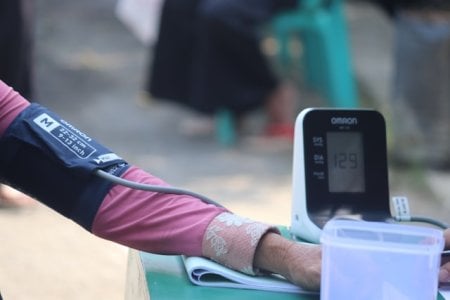This silent killer in your body costs billions of dollars yearly
By
Seia Ibanez
- Replies 9
Health concerns often creep up quietly, becoming serious before we even notice.
One such issue continues to challenge Australians and the nation's healthcare system.
High blood pressure, often termed the 'silent killer', is a pervasive health issue that not only poses a significant risk to individual well-being but also weighs heavily on the Australian economy.
A recent study by the George Institute for Global Health has revealed the staggering economic burden of high blood pressure.
It revealed that treating high blood pressure costs the nation more than $1.2 billion annually.
Patients cover approximately 40 per cent of the treatment costs, which include general practice consultations and medications. Taxpayers shoulder the remaining 60 per cent through government initiatives.
Over the past decade, from 2012 to 2022, the cumulative cost to Australians has been a staggering $12.2 billion.
‘We estimate that about $1.2 billion was spent on treating hypertension in Australia during 2021–22 and that 42 per cent of this cost was borne by patients as out-of-pocket costs,’ the study said.
‘The largest components of expenditure were pharmacy fees (50.9 per cent), general practice consultation costs (28.5 per cent), and pharmaceutical manufacturer costs (18.4 per cent).’
Anthony Rodgers, a contributor to the study, described Australia as facing a hypertension crisis.
‘There is a trend upwards in the number of Australians with high blood pressure, which would be impacted by factors such as our over-reliance on packaged foods that often contain too much salt,’ he said.
‘But basically, it has been a major issue for a long time, and it isn't getting better.’
‘With its role in heart attack and stroke well understood, it's important to try and get it more controlled than we have done, as well as put efforts into prevention, of course.’
‘But a very large number of people in Australia have hypertension that is untreated or undertreated.’
According to the Australian Institute of Health and Welfare, high blood pressure is a leading cause of death in Australia, contributing to around 25,000 deaths per year.
‘Finally, but perhaps most importantly, 41 per cent of expenditure comprises out-of-pocket costs for patients, which has major implications for equitable access and outcomes,’ the study said.
‘Out-of-pocket pharmaceutical expenses can be significant barriers for people in low-income households with one or more chronic conditions.’
Researchers have pointed out that while the federal government's 60-day prescription scheme is a step in the right direction, more needs to be done to reduce treatment costs and improve accessibility.
One promising approach is to enable greater use of extended prescription schemes, aligning with the World Health Organization's recommendations and practices in other countries.
‘The low-hanging fruit would be enabling more use of [the scheme],’ Dr Rodgers said.
‘Ninety days is the norm in many countries and recommended by the World Health Organisation, so we can learn from those settings.’
‘Expanding programs for other healthcare professionals like pharmacists and nurses to get more actively involved in team-based care is a tried and proven strategy overseas as well.’
According to a spokesperson from the Pharmacy Guild of Australia, innovative methods to improve hypertension diagnosis and treatment are already being implemented in Australia.
‘Patients with hypertension are now able to get simple blood pressure and cholesterol checks at some pharmacies, and we would like to see this rolled out across all states and territories,’ they said.
‘Last year, the Pharmacy Guild of Australia was successful in advocating for a cut in the prescription co-pay from $42.50 to $30.’
‘This has saved patients $346 million already, and the guild was successful in working with the government to freeze the concessional patient co-pay for up to five years.’
 Have you faced challenges in managing or affording your treatment? What changes would you like to see to make healthcare more accessible and affordable? Let us know in the comments below!
Have you faced challenges in managing or affording your treatment? What changes would you like to see to make healthcare more accessible and affordable? Let us know in the comments below!
One such issue continues to challenge Australians and the nation's healthcare system.
High blood pressure, often termed the 'silent killer', is a pervasive health issue that not only poses a significant risk to individual well-being but also weighs heavily on the Australian economy.
A recent study by the George Institute for Global Health has revealed the staggering economic burden of high blood pressure.
It revealed that treating high blood pressure costs the nation more than $1.2 billion annually.
Patients cover approximately 40 per cent of the treatment costs, which include general practice consultations and medications. Taxpayers shoulder the remaining 60 per cent through government initiatives.
Over the past decade, from 2012 to 2022, the cumulative cost to Australians has been a staggering $12.2 billion.
‘We estimate that about $1.2 billion was spent on treating hypertension in Australia during 2021–22 and that 42 per cent of this cost was borne by patients as out-of-pocket costs,’ the study said.
‘The largest components of expenditure were pharmacy fees (50.9 per cent), general practice consultation costs (28.5 per cent), and pharmaceutical manufacturer costs (18.4 per cent).’
Anthony Rodgers, a contributor to the study, described Australia as facing a hypertension crisis.
‘There is a trend upwards in the number of Australians with high blood pressure, which would be impacted by factors such as our over-reliance on packaged foods that often contain too much salt,’ he said.
‘But basically, it has been a major issue for a long time, and it isn't getting better.’
‘With its role in heart attack and stroke well understood, it's important to try and get it more controlled than we have done, as well as put efforts into prevention, of course.’
‘But a very large number of people in Australia have hypertension that is untreated or undertreated.’
According to the Australian Institute of Health and Welfare, high blood pressure is a leading cause of death in Australia, contributing to around 25,000 deaths per year.
‘Finally, but perhaps most importantly, 41 per cent of expenditure comprises out-of-pocket costs for patients, which has major implications for equitable access and outcomes,’ the study said.
‘Out-of-pocket pharmaceutical expenses can be significant barriers for people in low-income households with one or more chronic conditions.’
Researchers have pointed out that while the federal government's 60-day prescription scheme is a step in the right direction, more needs to be done to reduce treatment costs and improve accessibility.
One promising approach is to enable greater use of extended prescription schemes, aligning with the World Health Organization's recommendations and practices in other countries.
‘The low-hanging fruit would be enabling more use of [the scheme],’ Dr Rodgers said.
‘Ninety days is the norm in many countries and recommended by the World Health Organisation, so we can learn from those settings.’
‘Expanding programs for other healthcare professionals like pharmacists and nurses to get more actively involved in team-based care is a tried and proven strategy overseas as well.’
According to a spokesperson from the Pharmacy Guild of Australia, innovative methods to improve hypertension diagnosis and treatment are already being implemented in Australia.
‘Patients with hypertension are now able to get simple blood pressure and cholesterol checks at some pharmacies, and we would like to see this rolled out across all states and territories,’ they said.
‘Last year, the Pharmacy Guild of Australia was successful in advocating for a cut in the prescription co-pay from $42.50 to $30.’
‘This has saved patients $346 million already, and the guild was successful in working with the government to freeze the concessional patient co-pay for up to five years.’
Key Takeaways
- High blood pressure is a significant health concern in Australia, costing the economy over $1.2 billion in a year.
- The study by the George Institute for Global Health reveals that patients bear 42 per cent of the treatment costs out-of-pocket, which can be a barrier for those from low-income households.
- The trend of high blood pressure is worsening in Australia, with many cases being untreated or undertreated, necessitating better control and prevention measures.
- Efforts are being made to reduce treatment costs, including the introduction of the 60-day prescription scheme by the federal government and advocacy for reduced prescription co-payments by the Pharmacy Guild of Australia.








